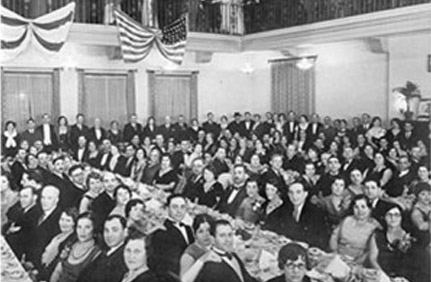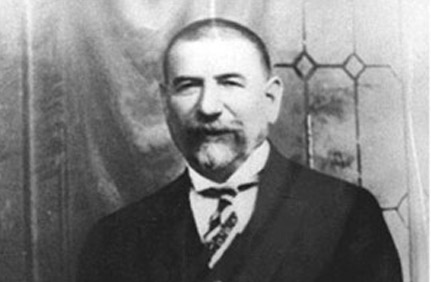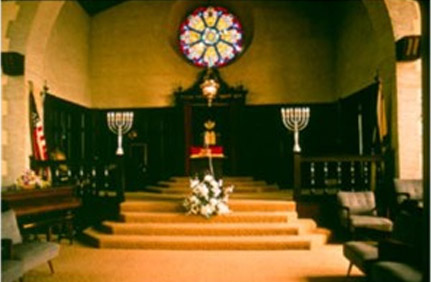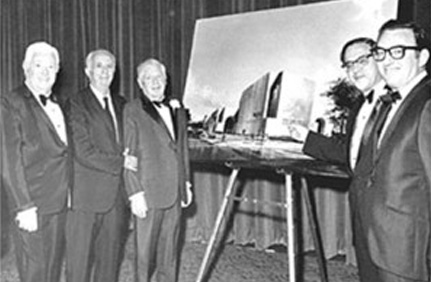HISTORY
A Tradition of Unity
As a precursor to the history of the Sephardic Temple Tifereth Israel in Los Angeles, it should be noted that Sephardic Jews were in the city as early as 1853 albeit for a short time. Two of importance were Solomon Nunes Carvalho, a photographer and artist who previously was a member of the Fremont Expedition to California in 1853 and Samuel K. Labatt a retailer in dry goods. In 1876 David d’Ancona made a brief trip to Los Angeles. He wrote in his diary, “Los Angeles is the Damascus of America.”
The real emphasis of the Sephardic community wasn’t felt until the beginning of the 20th century, the predominant influx coming from the Ottoman Empire. They came from Salonica, Egypt, Turkey , Rhodes and other points of the middle east. Not only did these Sephardim have a different culture from their Ashkenazi brethren but this remained(to an extent) the same within their own culture , primarily because of the distance that separated them from one area to the next. This also caused them to be disorganized which in turn resulted in the lack of proper religious and educational facilities.
The first Sephardic Jew to arrive in 20th century Los Angeles was Mordecai Zeitoun, a veteran of the Franco-Prussian War of 1870-71, a native of Algeria. He was an entrepreneur in the Louisiana Purchase Exposition at St. Louis, Missouri in 1904. “Papa” as he was affectionately known, along with his daughter Rose arrived in Los Angeles during the closing months of 1904, probably in October or early November. They were followed by brothers Louis and David Bramy. Davidmarried Rose Zeitoun on March 6, 1906 and their son, Roger was the first known Sephardi to be born in Los Angeles on February 14, 1907.
Another early Sephardic arrival was Jacob(Jack) Caraco. Names like Baruch, Cohen and Levy plus a listing of a Portuguese Jewish Colony (probably the Avat ShalomCongregation founded in 1912) was included in the honor roll of the first Jewish Federation dated 1912.
Following the arrival of the Zeitouns, Bramys and Caracos, other families, future members of the Los Angeles Sephardic Community began arriving from all points east. Young immigrants such as Marco Tarica, Morris Soriano, Joseph M. Mayo, Jack Notrica, Isador M. Hattem, Isaac Raphael, Ovadiah Haim, Mandolino Levy and others. By 1912 the Avat Shalom Society was founded.
In the beginning, for a few years the fledgling congregation flourished, but soon with additional arrivals from various parts of the Levant, ethnic differences and parochial arguments ensued and it was just a matter of time before the Avat Shalom Society was dissolved.
In 1917 the Peace and Progress Society was formed with members mostly from the Island of Rhodes, at the time still under the aegis of Turkey. In 1935 the name was changed to the Sephardic Hebrew Center and still later to Sephardic Beth Shalom. Others of the dissenters organized the Haim VaHessed Society or the Sephardic Brotherhood of Los Angeles.
By M. I. Bob Hattem Archivist / Historian
In order to attract the younger generation, several elders of the Sephardic community – those mostly from Turkey proper, decided that it was about time the Sephardim of Los Angeles were united into a large congregation, build a temple and have an ordained rabbi. Unfortunately this dream of the elders did not materialize, for the moment at least. They did, however organize a formal community on Sunday, February 1, 1920. Then and there 40 young immigrant souls bound themselves spiritually together and formed the Sephardic Community of Los Angeles otherwise known as La Communidad. Rabbi Abraham Caraco served as the first rabbi of the community.
The first book of minutes dated 1 February 1920 reads, “Communidad sefardi de Los Angeles, domingo 1 de febrero de 1920 en Los Angeles,California – Walker Auditorium, 730 S. Grand Avenue a las 2:00 P.M. Respondiendo al llamaniento de los presidentes Mandolino Levy y Jose M. Estrugo acudieron en asamblea general a las personas siguentes.”
And so it was on this historic date that the Sephardic Community of Los Angeles (La Communidad Sefardi) was founded with thirty-nine men in attendance. The founders present at the first organizational meeting included Carlos Abolafia, Leon Anticoni, Solomon Beraha, Raphael Behar, Abraham Caraco (the first rabbi of the young community), Isaac L. Caraco, Ralph Caraco, Maurice Carasso, NissimCohen, Marcos Cordova, Adolphe de Castro Danziger, Harry Eskenazi, Sam Ezra, Jose Estrugo, Ovadia E. haim, Jacob Haim, Jim Habif, Isadore Hatem, Robert Hatem (Hatem changed name to Hattem between 1914 & 1918), Mandolino Levy, Sam Max, J. Mazza, S. Mazza, Salvador Meshulam, Raphael Nahmias, N. Nissim, Jacob(Jack) Notrica, Sam Passy, Alfred(Albert) Rugeti, Isaac Raphael, Jake Sheby, Mordechai Sheby, Maurice Soriano, Saki Souza, Isaac Tovil, Morris Tovil, Alex Tobey and Mordechai Zeitoun.
Mandolino Levy was the provisional president for this very first meeting of La Communidad as it was to be known, and Mr. Adolphe de Castro Danziger was elected the first president of the fledgling organization. Jose Estrugo was elected vice president and secretary. The minutes also note that monthly dues would be $1.00 for each member.
1924 was the year of the first temple family picnic held in Sunland, California. A picture of the attendees to the picnic is located in the temple archives office. It is also the year the Communidad purchased property for a synagogue at 52nd. Street and Second Avenue in southwest Los Angeles. It was impossible to build on the property at the time because temple funds were practically exhausted. Rabbi Caraco died in 1925 and the second rabbi of the community was Rabbi David Tovi who was the spiritual leader for the balance of the 1920s and into the 1930s. Moise H. Hattem acted as the first Gabbai and cantors were made up of volunteers from the community. In 1925 the Sephardic Sisterhood was founded by Mme. Rebecca Hattem. A photo of the Sisterhood founders can be found elsewhere in this web site.
By 1928 the membership had increased sufficiently to preclude using the 52nd. Street property as a home for the growing community. The property was sold and plans were made to build a temple on the corner of then Santa Barbara and LaSalle Avenues. The site was purchased for $12,000.00. From then to the ground breaking ceremony which would take place in 1931 a series of fund raisers and banquets were held to raise money for he construction of the temple.
By 1931 La Communidad grew to a little over 125 members and the time had come for the ground- breaking of the soon-to-be-built kehila or synagogue. Ground-breaking ceremonies took place on September 1, 1931. This occurred under the administration of Salvador Meschulam. Signatures of the original founders and those at the ground-breaking ceremonies can be found on documents located in the temple archives.
Much hard work followed and by 1932, in the depths of the greatest depression this country has ever known, the synagogue, Tifereth Israel was completed and dedicated right on schedule. The Santa Barbara Avenue Temple was the first Sephardic synagogue be built in Los Angeles. It was a lovely California style building in cream color stucco with an interior that followed the classic Sephardic design. The tevah or reader’s desk was in the center of the sanctuary. It faced the Ehal (ark)and the worshipers sat along side one another both women and men together so as not to separate families. As Rabbi Ott would later describe, “the congregants face each other instead of seeing the back of the necks of the people sitting in front. The rabbi isn’t the center of the service. The Torah is and the community sees itself around it.
The temple was dedicated on February 21, 1932 with invited guests including the mayor of Los Angeles and other dignitaries of the day. One month later in march, 1932 the first three Bar Mitzvahs in the new synagogue took place. Maurice I. Hattem was Bar Mitzvah on March 26, 1932 as was Elias Morjoseph and the late Ted Cadis of blessed memory during the same month. The first wedding occurred in October of that year. Victor Behar and Alice Cohen were married.
In 1935 a group known as the Juniors of Temple Tifereth Israel was founded with Jack Cohen as its first president. Isaac R. “Ike” Caraco was the second president and Morris Hazen was the third. Originally the group was made up of Tifereth Israel members but soon it included members from the Sephardic Hebrew Center and even some Ashkenazi members. A microcosm of the Los Angeles Jewish Community, so to speak.
It was in May of 1933 that a Talmud Torah was founded under the leadership of Jessie Caraco, Chairman of the Talmud Torah Committee. This was during the administration of Raphael S. Amado. During the later part of the 1930s the property adjacent to the synagogue was purchased to improve the parking facility. This was carried out under the administration of Jack Kiok.
Prior to World War II monies were raised to help the United Jewish Welfare Fund, the different Jewish agencies in Europe and Palestine and work was beginning to help the war effort.
Following World War II there were some new innovations to the community. A choir was started under the direction of the late Norma Carmona of blessed memory and Friday night services were becoming more frequent. Rabbi Tovi had died and was replaced by Rabbi Axelrod for a short period of time. He was replaced by Rabbi Friedman who had been a rabbi in Florence, Italy. Reverend Isaac M. Varon who was the temple secretary also acted as the Hazzan or Cantor. Aron Cohen a past president of the community took over the job of Gabbai of the community upon the passing of Moise H. Hattem in 1951. He held that position for over 50 years until he passed away.
During this period the small children of the 1920s and early 1930s were growing up and there were many Bar Mitzvahs and weddings. Now that the war was over and times were better the membership began to increase and soon the Santa Barbara Temple wasn’t large enough to hold the membership as it once did.
About this time some parochial arguments ensued as to the rabbi’s tenure and finally it came to a point where Rabbi Friedman resigned his position of rabbi. This had to be done in order to placate the two factions that were forming -a pro Rabbi Friedman and an anti Rabbi Friedman. It was about this time that discussions with the Sephardic Brotherhood Community, Haim VaHessed and the Sephardic Community of Los Angeles were held with reference to a forthcoming merger of the two communities.
1959 was quite an eventful year for the community. This was the year they merged with the Sephardic Brotherhood known as Haim VaHessed. This was the group that split with the Sephardic Community in 1926 and formed their own community. Now they have merged together again. The community’s name was changed to The Sephardic Community and Brotherhood of Los Angeles. This was also the year that Rabbi Jacob M. Ott was invited to be the spiritual leader of the community on a trial basis. The”trial” lasted for 33 years until he retired in 1992.
As the community grew through the years, the Santa Barbara Avenue Temple became too small, and as most of the members of the congregation had moved west, there was a strong urge to move to West Los Angeles. The leaders of the Santa Barbara Avenue Temple saw the need to preserve the unique culture, heritage and religious rites(minhag) of the Sephardim in an overwhelmingly large Ashkenazic community, as well as to help new families in the area and educate the children in the Sephardic culture. A large plot of land was purchased on Wilshire Boulevard, one of the most magnificent avenues of Los Angeles, at the corner of Warner Avenue. Plans for the architecture were carefully considered, and finally it was agreed that the temple should be made of stones, to look like the stones of Jerusalem. It was to be built in the style of the Old City of Jerusalem. The resulting building, the only one of its style, stands impressively on the city’s major boulevard. It is a fitting tribute to the vision of the late Maurice Amado of blessed memory.
An historic ground-breaking took place in 1970. His excellency Itzhak Navon, Israel’s first president of Sephardic origin, in a message to Rabbi Jacob Ott, expressed the hope that “along with physical development there will be corresponding growth in the temple’s spiritual and cultural influence among young and old in the community.”
By this time there were over 600 members in the temple family and growing!
In 1975 the move to the Wilshire & Warner site was made albeit the temple sanctuary hadn’t been built as yet. Services were held in the social hall known as Amado Hall in memory of Maurice Amado one of the temple’s benefactors.
In 1979 a two day festival, Sephardic ‘79 was held in the sanctuary site as a fund raiser for the new temple sanctuary. In September, 1981 the temple sanctuary was dedicated. It was a dream come true. In the words of the B’nai B’rith Messenger, which described the ceremony as follows. In a tradition as old as the Exodus itself, they marched with their Youth and their elders together in a procession with canopy and song taking the Sifrei Torah to the new main sanctuary of Sephardic Temple Tifereth Israel which was dedicated on Sunday, September 15.
The impressive ceremony was the culmination of two decades of effort to bring about the complete relocation of Sephardic Temple Tifereth Israel from its Santa Barbara Avenue location dedicated some 50 years ago, to the new Wilshire Boulevard location, at Warner Avenue. Witness to this full cycle of development was Rabbi Edgar F. Magnin, of Wilshire Boulevard Temple who spoke at the dedication of the old temple on Santa Barbara Avenue, and also delivered the inspirational message for the new sanctuary’s dedication.
There was hardly a dry eye among the more than 1000 guests when the blasts of the Shofar (rams horn) greeted the procession of Torahs being brought into the new sanctuary. It was with joy and gladness that the congregates reached out to kiss the torahs as they were paraded seven times around the temple. It was the same emotional spirit that Aron Cohen, the temple’s Gabbai for half a century pronounced the prayer of thanksgiving before the torahs placed in the new ark with song and prayer led by Cantor Isaac Behar.
The main sanctuary is a gift of the Maurice Amado Foundation to the temple. The foundation was established before his death by the late Maurice Amado, a leading Sephardic philanthropist. Richard Amado, the foundation president made the presentation which was accepted by Hyman Jebb Levy, the temple’s president. Ralph A. Amado, Chairman of the Building Committee is the grandson of Raphael Amado, along with Isadore M. Hattem and Morris Passy were leaders in the building of the first temple on Santa Barbara Avenue.
Max Candiotty, Chairman of the Temple Religion Committee was Master of Ceremonies. A highlight of the event was the appearance and an address by California Governor Jerry Brown. In his dedicatory address Rabbi Ott highlighted the concept of the spirit of the new temple, saying that it was,” new in substance but old in spirit and tradition.” The colorful ceremonies concluded on a note of solemnity and inspiration when Aron Cohen led the congregation in a memorial prayer for the repose of the souls of the builders who departed, and when Cantor Behar led the congregation in the afternoon service.
In 1980 member Bob Hattem suggested to then president Lou Alcalay that there should be a monthly temple newsletter instead of the infrequent bulletins that were published usually during the High Holidays. He appointed Bob as Chairman of the Publications committee and the newsletter, El Shofar, the name at Lou’s suggestion was born. Bob was appointed as the first editor and the first issue was published in January of 1981. Bob retired in 1987 to become the temple’s first archivist/historian. The second editor was Sue Halfon of blessed memory, followed Jack Israel and the current editor is Vicki Karmona.
On the morning of October 1, 1987, King Juan Carlos I and Queen Sofia were greeted on the steps of the temple by Rabbi Ott, Dr. Seymour Eiseman, president of the congregation, Mrs. Raquel Bensimon, Senior Vice President and Mrs. Arlette Cohen, president of the Temple Sisterhood. When the royal couple entered the sanctuary they were honored by the blasts of six shofroth (rams horns) led by Cantor Isaac Behar and a jubilant congregation singing Havenu Shalom Alehem. It was for all a new page of history in the making; the Sephardim had waited, sometimes with hope, sometimes with dispair for five hundred years to witness such an event.
For forty-five wonderful minutes it was Camelot Sephardic style. Speeches were made, presentations were made and even the 5.5 earthquake that shook Los Angeles that morning didn’t make any difference. It was the first time in over five hundred years that a Spanish monarch had visited a Jewish synagogue and all in attendance enjoyed every moment. In 1993 Sephardic Temple Tifereth Israel and Sephardic Beth Shalom, the former Sephardic Hebrew Center merged and after 80 years the congregation of Avat Shalom of 1912 was once more one spiritual family.
Following their retirement, Rabbi Ott was replaced by Rabbi Bouskila and Cantor Mizrahi was replaced by Haim Mizrahi. Rabbi Refael Cohen is the current Senior Rabbi.
As of 2002 the Sephardic Temple Tifereth Israel, as it is now known has a congregation of well over 1000 families, second only to New York’s Spanish and Portuguese Congregation, Shearith Israel.
For young professionals in their 20’s and 30’s we hold Friday night dinners on a regular basis, during which they can meet other like-minded singles, and forge social and professional connection while enjoying and celebrating together the sanctity of the Sabbath.
Every fourth Shabbat morning, we hold a Torah class (“lunch and learn”), following kiddush and services.
In addition to all that, we also offer throughout the year manifold and diverse programs, including world renowned guest speakers, movie nights, and much more
The Levy Family ECC of Sephardic Temple strives to promote positive relationships in children, instilling self-esteem and confidence while respecting each child as a unique learner.
In the Hebrew School our goal is to inspire and empower our students to become excited and knowledgeable about our Jewish heritage so that they can make great improvements in their community, nation, Israel, and the world.
Sephardic Temple Tifereth Israel designs activities for all members: toddlers, youth, singles, couples, families and seniors. These events serve to foster and build friendships and keep our members connected to our community. We host family Shabbat dinners where families and friends share a special Shabbat service and meal. We offer book clubs, theaters, family picnics, educational lectures and discussions with guest speakers, trips to museums and Hollywood bowl nights and much more.
The Matilda Seror Gift Shop offers exquisite Judaica, art, jewelry and books. Our members form lasting friendships through our dinners, dances, game nights, seminars, community service, business networking, and special outings. Our youth bond through programs offered throughout the year.








